|
The final draft of "Days in the Life" has been submitted and should be available for purchase by Monday, August 1 on Amazon.com
1 Comment
Today, being the 20th day of the month, is the day I send out my newsletter. Inspired by popular interest, I began this free monthly email newsletter in March 2014, when I sent that initial issue to six people. Little by little it's grown to the point where this morning's newsletter (August 2016) was sent to 753 recipients. Each newsletter details my schedule for the remainder of the current month through the end of the next month - which programs I'm giving, where, and when. Anybody with a valid email address may register for the newsletter on my website: http://www.aaronkrerowicz.com/newsletter-sign-up.html. Just be sure to type the “prove you are human” part. (I get a lot of spam, so any submissions that skip that step are deleted.) Newsletter subscription is the best way to stay in touch. The emails are sent from my personal Gmail account, which allows recipients to respond easily and efficiently. This permits me to maintain a monthly dialog with Beatles fans across the globe. Plus, they feature adorable puppy pictures. In honor of my new pooch, Abbey (as in Road), I started including a photo of her in each newsletter beginning in 2016. Here's August's: Lastly, Days in the Life, a travelogue of my and my father's tour in March 2016, will be released on July 28 - less than two weeks from today. In anticipation, here's the "Interview with the Authors" section (found at the end of the book):
I have a confession to make: In pigeonholing Ringo's drumming into three fundamental beats (metronomic, rock, and syncopated), I'm guilty of oversimplification. My goal is to draw large-scale conclusions on how Ringo plays the drum set. To do that, however, I have to categorize and lump together drum patterns that are similar and but not necessarily identical. Such generalizations help provide conceptual understanding but simultaneously glosses over the subtle diversity of reality. Ringo just payed drums - he didn't care at all about classification. In that regard, my analyses are a somewhat artificial construct. That's why this fifth and final blog analyzing Ringo's drumming will look at blends of those three primary categories - drum beats that don't fit perfectly into any category but rather fall in between. The most common blend is the metronomic rock beat, in which one drum (usually the snare or bass) will maintain a constant pulse while the other will maintain its rock pattern (bass on 1 and 3; snare on 2 and 4). Examples of the metronomic rock beat in which the bass is metronomic while the snare is rock can be heard:
Examples of the metronomic rock beat in which the snare is metronomic while the bass is rock can be heard in the verses of 'When I'm Sixty-Four', 'Honey Pie', 'Piggies' (in which the tambourine substitutes for the snare), and 'The Continuing Story of Bungalow Bill' In rare instances, BOTH bass and snare are metronomic, but the accents in the snare on 2 and 4 suggest a rock pattern. This is found:
And in a single instance, neither a bass nor a snare but a tom plays the metronomic beats: the refrains and break of 'Money (That's What I Want)'. * * * * * * * * * Less common are syncopated metronomic beats, in which one drum (again, bass or snare) maintains a metronomic pattern while another drum articulates a syncopated pattern. In the refrains of 'I Don't Want To Spoil The Party', for example, the bass hits constant quarters [1 |2 |3 |4 ] while the low tom plays [1 |2 & | & |4 ]. In the choruses of 'Good Day Sunshine', which alternate between 3/4 and 5/4 measures, the snare maintains a quarter note pulse while the bass and cymbals are syncopated. Lastly, 'Getting Better' is a bit of an anomaly. The bass is metronomic (constant quarters), while the snare hits beat 2 and the cymbal on the & 3. Technically, it's not syncopated because all four beats are present and accounted for. But with that cymbal hit on an off beat, it sure sounds syncopated! For lack of a better category, I file it under "syncopated metronomic". Careful readers might be wondering about a syncopated rock beat. That would be the logical next step. Perhaps this could be a [1 |2 (&) | |4 (&) ] pattern, such as found in 'Slow Down', which is about as close to being a rock beat as it can be without actually being a true rock beat. But all things being equal, it's best to select the simplest option. In this case what might be dubbed "syncopated rock" fits better under just "syncopated". (See yesterday's blog for details.) * * * * * * * * * While beats can be blurred, as the above illustrates, it's more common for Ringo to use different beats within the same song to reinforce the song's structure. He might use, say, a syncopated beat in the verses and a metronomic beat in the bridges to contrast. Indeed, he does exactly that in 'All My Loving'. Similarly, the verses and choruses of 'Can't Buy Me Love' use a rock beat, while the intro and coda use a metronomic beat. And lastly, the verses of 'Ticket To Ride' are syncopated, while the bridges are rock. * * * * * * * * * Other times he'll use variations of the same beat (instead of different beats) to reinforce structure. In 'I've Just Seen A Face', the verses and choruses use metronomic beats, but the former uses brushed snare drum while the latter supplements that with a shaker. Similarly, in 'I Want To Hold Your Hand', the verses and the bridge both employ rock beats, but the former is [1 |2 & |3 |4 ] and lets the cymbals ring, while the latter is [1 |2 |3 & |4 & ] and mutes the cymbals. And in ' Glass Onion', parts of Verse A feature a [1 |2 & | |4 ] syncopated pattern, while Verse B incorporates a [ |2 |3 & |4 & ] beat. * * * * * * * * * All of the above is quite sophisticated. But 12 tracks take things to an even higher level by combining all three styles of beat (metronomic, rock, and syncopated) into a single track. Typically, the very end of each blog is where I promote my next (ie tomorrow's) gig. In this case, however, there was a bit of a miscommunication regarding July 15. When the Library Director of the Media-Upper Providence Free Library in Media, PA, emailed me asking, "Could we have you perform on July 15?", what she apparently meant to say was, "I do not want you to speak at my library on July 15." Silly me for misinterpreting! Though, how she misinterpreted my email confirming the booking on that date remains a mystery...
July 14: "A Four-Headed Monster: The 4 Beatles in 5 Songs" at the Women's Civic Club of Stone Harbor7/13/2016 PART 4 of 5: RINGO'S SYNCOPATED DRUMMING Having analyzed Ringo's metronomic drum beats the other day and his rock beats yesterday, today I look at his syncopated beats. Where both the metronomic and rock patterns articulate all downbeats, syncopated patterns are defined by the absence of articulation on at least one downbeat. This gives a "limping" effect (imagine the instability of walking on a peg leg) since the rhythms are not as solid because they don't articulate all the beats. From an analytic standpoint, syncopated beats are the most musically complex. They are also the least common. Where metronomic drumming is heard in 71 (33.6%) of the Beatles' 211 tracks and rock drumming is heard in 166 (78.7%), syncopated drumming is heard in just 44 songs (20.9%). The previous blogs aimed to illustrate what the metronomic and rock beats were and illustrate how Ringo used them - NOT to create an exhaustive catalog of EVERY example of those two patterns. But because of the comparative scarcity and complexity of the syncopated beat, such an exhaustive catalog IS the goal for this post. I will systematically address and classify each of the 44 Beatles tracks on which Ringo plays a syncopated beat in order of frequency. MISSING BEAT 3 AND ONLY BEAT 3 By far the most common syncopated pattern omits beat 3 and only beat 3. This is the case in 29 of the 44 tracks to employ a syncopated beat. (Another 9 tracks omit beat 3 but also omit at least one other beat. Those will discussed momentarily.) Of those 29, 15 employ the pattern [1 |2 & | |4 ] or the nearly identical [1 |2 & | |4 & ] or a combination of the two. Of those 15, seven articulate the bass drum on the & of 2, essentially taking the rock beat and moving up the second bass drum hit one eighth note to create a syncopated beat:
By contrast, 'All My Loving', 'Little Child', 'Don't Bother Me', 'Revolution', and 'Revolution 1' make the & of 2 snare hits (instead of bass drum hits). Lastly, the bridges of 'The Night Before', the verses of 'I Feel Fine', and the solo and fifth and sixth verses of 'I Want You (She's So Heavy)' place tom toms on 2 and the & of 2. * * * * * * * * * Of those 29, another six employ the pattern [1 |2 & | & |4 ] or the nearly identical [1 |2 & | & |4 & ] or a combination of the two. Three of those six put the bass on 1, the & of 2, and the & of 4, the snare on 2 and 4, and a closed hi-hat on the & of 3:
Both 'Paperback Writer' and 'Here Comes The Sun' place snare hits on beats 2 and 4, and bass hits on 1, the & of 2, and the & of 3 (and sometimes the & of 4), giving it the same [1 |2 & | & |4 (&) ] rhythm as the three songs above, but with different articulations. Lastly, the third section of 'You Know My Name (Look Up The Number)' employs the same rhythm, but using bongos. * * * * * * * * * The remaining eight syncopated patterns that omit beat 3 and only beat 3 are unique (not found in any other Beatles song). [1 &a|2 & | & |4 & ] is unique to third phrase of the verses in 'Please Please Me' [1 |2 | |4 (&) ] is unique to 'Thank You Girl'. [1 |2 | |4 ||1 |2 & | |4 (&) ] is unique to 'Slow Down'. [1 (a)|2 & | (&) |4 & ] is unique to 'Mr. Moonlight'. [1 |2 & | & |4 ] is unique to the refrains 'I Don't Want To Spoil The Party' (which simultaneously employs a metronomic bass drum pattern). [1 |2 a| & |4 ] is unique to the bridges of 'Taxman'. [1 |2 & | &a|4e& ] is unique to the refrains of 'She Said She Said'. Lastly, [1 | & | ||1 |2 & | & |4 ] is unique to the tags of 'Everybody's Got Something To Hide Except For Me And My Monkey', the second measure of which fits the current category (the first, however, does not). MISSING BEAT 4 AND ONLY BEAT 4 This is found in just three tracks. Each of these three employs a different variation within the "missing beat 4 and only beat 4" framework. Thus, no overall patterns emerge so they will be considered individually. The choruses of 'She Loves You' maintain a two-measure drum pattern, the first of which is a standard rock beat, the second uses quarter note triplets which do not articulate beat 4. Since Ringo adopts the same rhythms as that guitar on 'Ticket To Ride', and the guitar lick omits beat 4 ([1 |2 & |3 & | & ]), the drums also omit beat 4. Lastly, 'Tomorrow Never Knows' adds toms on the & of 3 but leaves out beat 4 entirely: [1 |2 & |3 &a| ]. MISSING BEAT 1 AND ONLY BEAT 1 Like the previous category, only three tracks fit this criteria: the third phrase of each verse in 'No Reply', some of the verses in 'Glass Onion', and parts of the beginning of 'The End'. Unlike the previous category, however, all three of these songs fit into the same rhythmic pattern: hits on the & of 4 essentially anticipate the initial downbeat of the subsequent measure. : MISSING BEAT 2 AND ONLY BEAT 2 The last category to omit a single beat contains just two examples, both of which use the same rhythm: [1 | & |3 |4 ]. Interestingly, eight other tracks employ syncopated beats that omit beat 2, but they also omit other beats. MISSING BEATS 2 AND 3 The turnaround (retransition?) in 'Twist And Shout' uses the rhythmic cliche of 3+3+2 in [1 | & | |4 ]. The verses in 'Don't Let Me Down' employ the same rhythm, but in rather less energetic music. The [1 | & | |4 & ] initial two phrases of the verses in 'All I've Got To Do' are unique among Beatles songs, but reminiscent of the syncopated beats found in 'Anna (Go To Him)', 'It's Only Love', and 'In My Life' (see above). The initial two phrases of the verses in 'No Reply' employ a [1 | & | |4 || |2 | & | ] 2-measure rhythm, the first of which fits the current criteria... ... as does the first measure (but not the second) of the 2-measure tags in 'Everybody's Got Something To Hide'. Lastly, both 'Golden Slumbers' and 'Carry That Weight' incorporate the pattern [1 | & | & |4e& ], though they're not completely identical (notice how 'Slumbers' has a snare hit on beat 4 that is not found in 'Weight'). Note: There is no category "missing beats 2 and 4" because such a rhythm would fit better into the "metronomic" label. MISSING BEATS 2, 3, AND 4 The only song here is 'You Never Give Me Your Money', the second verse of which hits cymbals on [1 | & | | ] but leaves beats 2, 3, and 4 silent (except for the ring of the cymbals, of course). MISSING BEATS 1, 3, AND 4 Here, too, there is only one song: The initial two phrases of each verse in 'No Reply' features a 2-measure rim click rhythm, the second of which articulates [ |2 | & | ]. And if anybody has actually read this far and followed it all (or any of it), I'm impressed! :-) I drive to Setauket, NY this afternoon to deliver another round of Band of the Sixties at the Emma S. Clark Memorial Library this evening. And tomorrow I drive to New Jersey to deliver my newest program (debuted last month in Fort Wayne, IN):
Thursday, 14 July 2016, 7:00-8:00 p.m. Women's Civic Club of Stone Harbor, 96th & The Beach, Stone Harbor, NJ A Four-Headed Monster: The 4 Beatles in 5 Songs If you had to pick songs which represent each of the four Beatles, which would you chose? This 60-minute multimedia presentation observes and analyzes each band member through the lens of one or two songs: For Paul McCartney, “Yesterday”; for Ringo Starr, “In My Life”; for John Lennon, “Strawberry Fields Forever”, and for George Harrison, “Something” and “Here Comes the Sun”. PART 3 OF 5: RINGO'S ROCK BEATS While the metronomic beat (considered yesterday) is found in 71 (33.6%) of the Beatles' 211 tracks, the rock beat is more than twice as common, appearing in 166 (78.7%). The rock beat might be thought of as a subset of the metronomic beat because it, too, articulates all four downbeats. However, it does so in a specific way: with the bass drum on beats 1 and 3, and the snare on 2 and 4. 'I Saw Her Standing There' is a textbook example. The alternation of bass on odd beats and snare on evens defines this rock beat pattern, but Ringo will often supplement that basic framework, creating subtle varieties within this pattern. He sometimes gives the & of 1 to the bass in 'I'm So Tired'. He gives the & of 2 to the bass drum throughout 'Nowhere Man'. He adds the & of 3 to the bass drum throughout 'Michelle'. And he sometimes (but not always) adds the & of 4 to the bass drum in the verses of 'Hold Me Tight'. In 'While My Guitar Gently Weeps' he adds the & of 1, and the & of 3. In 'Doctor Robert' he adds the bass drum to the & of 2, and the & of 4. 'Here There And Everywhere' adds the & of 3, and the & of 4. 'Penny Lane' sometimes adds the & of 2, the & of 3, and the & of 4 in the choruses. And 'Revolution' adds the & of 1, the & of 2, the & of 3, and the & of 4. * * * * * * * * * The above are all examples of added bass drum kicks. In other songs he'll supplement with the snare, though this is less common and less diverse. 'Please Please Me', for example, features the snare on the & of 2. The opening phrase of the bridges in 'Fixing A Hole' add the snare on the & of 2, and the & of 4. And the introduction of 'What You're Doing' adds a few extra snare hits on the & of 3. * * * * * * * * * All of the above rock beat examples are from songs in simple meters (beats divisible by two, or swung). But some are in compound meter (beats divisible by three). 'Yes It Is' is in 12/8, but nevertheless implements a standard rock beat (bass on 1 and 3, snare on 2 and 4). This, too, can be supplemented (but always with the bass drum - for whatever reason, Ringo never supplements compound meter rock beats with additional snare hits), such as in the bridges of 'This Boy' and 'Good Morning Good Morning', and throughout 'Yer Blues'. Once again, this is not an exhaustive catalog of Ringo's use of the rock beat in Beatles recordings. I've cited 17 examples, but there are 148 more Beatles tracks not listed here that also employ this rock beat. Rather, the goal for this post is to illustrate what the rock beat is and to provide examples of the many different ways that Ringo uses that pattern in Beatles music. Tomorrow I'll do the same for his syncopated beats. The tour continues tomorrow with my third and final presentation in New York:
Wednesday, 13 July 2016, 7:00-8:00 p.m. Emma S. Clark Memorial Library, 120 Main St, Setauket, NY The Beatles: Band of the Sixties Explore the music of The Beatles in this 60-minute multimedia presentation (part history and part musical analysis) spanning the full 1960's: beginning with the band's seminal visits to Hamburg, continuing through Beatlemania, and concluding with Abbey Road. The program will be supplemented with audio clips of music and excerpts from interviews with the band members. PART 2 OF 5: RINGO'S METRONOMIC BEATS Of the three fundamental drumming patterns mentioned yesterday, the metronomic beat is the simplest because the pattern is the same on each beat. That being said, subtle differences can be found. But on a fundamental level, once the pattern is established it typically doesn't change. Take, for example, 'Across The Universe'. The only percussion used on the track (in both the 1968 and 1970 releases) is a constant quarter note bass drum. Ringo will often use metronomic patterns during passages that change meter because the solid beat helps ground the music. Indeed, 'Across The Universe' incorporates an occasional 5/4 measure in the verses, which does not effect the drum pattern in any way. Similarly, the choruses in 'Good Day Sunshine' (which alternate between 3/4 and 5/4), the verses of 'Good Morning Good Morning' (which maintain a constant beat despite various meters), the verses in 'All You Need Is Love' (which alternate between 4/4 and 3/4), and 'Two Of Us' (which is mostly in 4/4 but occasionally implements 3/4 and 2/4 measures) all employ metronomic drumming through metrically varying and/or ambiguous passages. The majority of Ringos' metronomic drumming patters, however, are found in metrically consistent passages. Just as he did through the changing meters of 'Good Day Sunshine', Ringo also hits the snare drum on every beat of the bridges of the always-common-time 'All My Loving'. Similarly, he hits the snare and bass together on every quarter note in the refrains and bridges of 'We Can Work It Out', in the first transition in 'Birthday' (the part where everything else drops out and it's just drums), and in the bridge of 'I've Got A Feeling'. He strikes the snare on every quarter note and the bass on every eighth note in the bridges of 'No Reply', in the choruses of 'Hey Bulldog', and in the bridges of 'Sexy Sadie'. And throughout 'Old Brown Shoe' and in the 'Rocky Raccoon' solos (and elsewhere) he alternates eighth notes between the bass and snare. While the loose definition of the metronomic beat is that every beat is the same, that's not always accurate. Sometimes that concept is expanded to encapsulate more than just one beat. In the bridges of 'Hold Me Tight', for instance, it's a two-beat pattern: beats 1 + 2 are identical to beats 3 + 4. This 1 + 2 = 3 + 4 metronomic beat pattern can also be found in the opening two phrases of each verse in 'Money (That's What I Want)', and in others. Most Beatles music is in duple or quadruple meter (divisible by two), but some is in triple (divisible by three). The metronomic concepts apply equally in such instances. The second part of the bridges in 'She Said She Said', for example, maintains a 3/4 meter, throughout which Ringo maintains a metronomic beat through constant quarter notes in the bass and constant eighth notes in the snare. 'Norwegian Wood (This Bird Has Flown)' employs two different metronomic beats, both in 6/8. In every third and fourth measure of the first bridge, the bass articulates a syncopated duple division of the triple meter. And in the second bridge, a 1 |2 |3& pattern between the bass and cymbals is maintained. The waltz bridges in 'Being For The Benefit Of Mr. Kite!' put the bass drum on beat 1 and answers that with hi-hat hits on 2 and 3, making the pattern 3 beats long (instead of 1 or 2 beats long, as illustrated above). Similarly, the verses and pre-choruses in 'Lucy In The Sky With Diamonds' both use metronomic beats in 3/4 time. The verse pattern lasts 3 beats; the pre-chorus pattern lasts 1. Metronomic beats are quite common in Beatles music. Of the 211 tracks they officially recorded and released between 1963-70, 71 of them (33.6%) feature metronomic drumming. So while the above is not an exhaustive list and catalog of Ringo's metronomic drumming patterns (I've cited 20 examples, but there are 51 more), it should give a clear idea of what they are and how they work. Meanwhile, I continue my mini tour tomorrow:
Tuesday, 12 July 2016, 7:30-8:30 p.m. Montauk Library, 871 Montauk Hwy, Montauk, NY The Beatles: Band of the Sixties Explore the music of The Beatles in this 60-minute multimedia presentation (part history and part musical analysis) spanning the full 1960's: beginning with the band's seminal visits to Hamburg, continuing through Beatlemania, and concluding with Abbey Road. The program will be supplemented with audio clips of music and excerpts from interviews with the band members. Ringo Starr gets no love. Fifty years after The Beatles peaked in popularity, their music remains in high esteem and references to the band are common and usually flattering. But references to Ringo specifically tend to be rather less flattering. In Season 3, Episode 7 of Breaking Bad, Walter White enters a hospital room to visit his partner, Jesse Pinkman, who had recently been beaten unconscious. Walter finds him horribly bruised, with two black eyes (the left swollen shut). "You're now officially the cute one of the group," jokes lawyer Saul Goodman to Walt. "Paul meet Ringo. Ringo, Paul." At the end of the 2014 film Jersey Boys, a biopic of The Four Seasons, band member Nicky addresses the question of why the group broke up: "It could have been an ego thing. Everybody wants to be up front. But if there's four guys, and you're Ringo? Better I should spend some time with my kids." And in the 2003 film Love Actually, adolescent Sam struggles with romantic interests despite coaching and encouragement from his father, Daniel. In one scene, they brainstorm a plan: SAM: Girls love musicians, don't they? DANIEL: Uh-huh. SAM: Even the really weird ones get girlfriends. DANIEL: That's right. Meatloaf definitely got laid at least once. For God's sake, Ringo Starr married a Bond girl. SAM: Whatever. Even John Lennon took potshots: "When I feel my head start to swell, I just look at Ringo and know we're not supermen." (Geoffrey Stokes' The Beatles, p. 102). Ringo Starr gets no love. In an effort to give Ringo long overdue credit, I put together a presentation highlighting his personality, drumming, singing, and songwriting. On 30 June 2015, I debuted Starr Time: A Celebration of Ringo Starr's Contributions To The Beatles at the Polk County Library in Bolivar, MO. In the audience was the librarian host, my dad, my grandma, and my grandma's half-sister. About half way through the hour-long presentation, another man walked in and stayed for the remainder. In other words, only one person not obligated to attend through either familial or professional commitment did so - and he was half an hour late. Ringo Starr gets no love. Discouraged but not defeated, I booked the program again. On 12 October 2015 I arrived at the LaGrange Association Library in Poughkeepsie, NY library with the hopes of drawing an audience closer to my average of 35. But this time the audience totaled zero. Ringo Starr gets no love. A couple weeks back I received an email from Peter Dean of www.KitePrint.com. He recreated the circus poster that inspired John Lennon's song 'Being For The Benefit Of Mr. Kite' from Sgt. Pepper's Lonely Hearts Club Band. He had found my BEATLES MINUTE video comparing the melodies of 'Mr. Kite' with 'It's Only Love' and expressed an interest in more such videos. I asked him if he might have suggestions for topics. He requested a video on Ringo to see why I hold him in such high regard. "I’ve always referred to Ringo as 'The luckiest man in the history of rock’n’roll'," he told me by email. "And, by extension, referred to George Martin as ‘the fourth Beatle'." Ringo Starr gets no love. And Peter isn't alone. Many Beatles fans dismiss him. And yet, Ringo was integral to The Beatles and their success. He might not have been the most technically skilled or flashiest percussionist, but for what that band needed at that time, they couldn't have found anybody better than Ringo. So, in a further effort to illustrate why Ringo deserves respect and adulation comparable to that of his band mates, I set to work on a BEATLES MINUTE video all about Ringo. But I quickly discovered a major problem: There's no way to fit it all into one minute - there's just too much to discuss. (Maybe I should initiate THE BEATLES HOUR?) With so much information to consider and process, I've decided to start in blog format. This post, then, be the first of five analyzing his considerable skills as a drummer. If I get a lot of comments and interest, I might take highlights of these findings to create videos. But if there's little interest or support (as has been the case so far), then I probably won't create said videos. * * * * * * * * * Ringo's drumming patterns fit into three basic categories: 1. Metronomic, in which every beat is the same. 2. The Rock Beat, in which the bass drum is hit on beats 1 and 3, and the snare hit on beats 2 and 4. 3. Syncopated, in which at least one beat is not articulated. Where today is an introduction, tomorrow (July 11) I will discuss how Ringo uses metronomic drum patterns. On Tuesday (July 12), I will consider his use of The Rock Beat. On Wednesday (July 13) I will analyze his syncopated drumming. And on Thursday (July 14), I'll show how these differing beats can be combined within a single song. The course of this blog series on Ringo's drumming will coincide with a mini tour that starts tomorrow:
Monday, 11 July 2016, 5:30-6:30 p.m. Rogers Memorial Library, 91 Coopers Farm Rd, Southampton, NY The Beatles: Band of the Sixties Explore the music of The Beatles in this 60-minute multimedia presentation (part history and part musical analysis) spanning the full 1960's: beginning with the band's seminal visits to Hamburg, continuing through Beatlemania, and concluding with Abbey Road. The program will be supplemented with audio clips of music and excerpts from interviews with the band members. |
Beatles BlogThis blog is a workshop for developing my analyses of The Beatles' music. Categories
All
Archives
May 2019
|
||||||










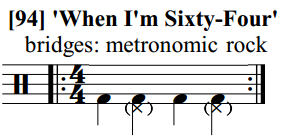








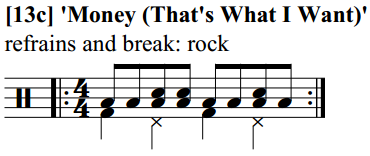





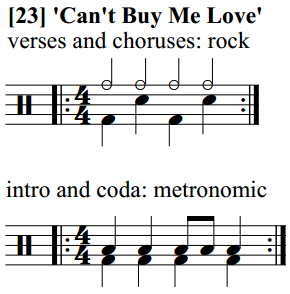
























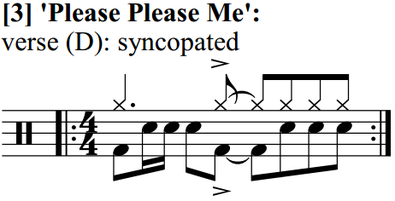





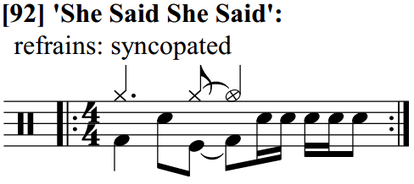
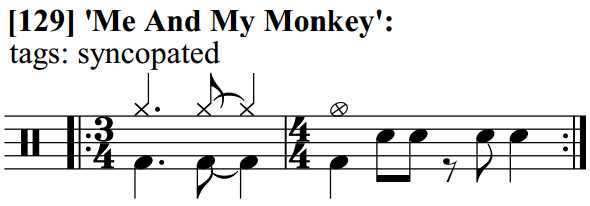






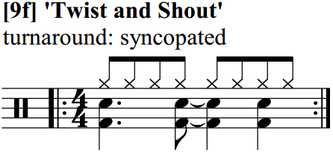









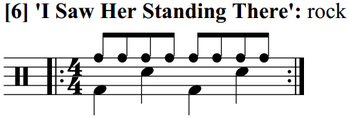









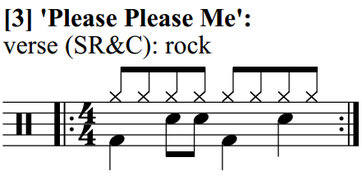




















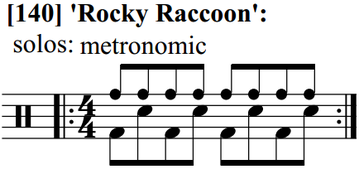






 RSS Feed
RSS Feed
